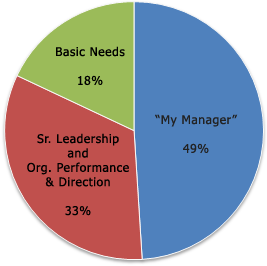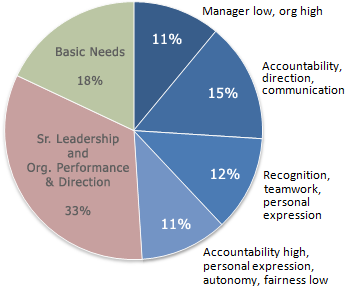Employee Disengagement
(part 2)Statistical breakdown of the causes of disengagement, plus how to diagnose and fix engagement problems between employees and their managers.
Primary Causes of Employee Disengagement

Senior Leadership and Organization Performance/Direction - lack of respect for or confidence in senior leadership, lack of organization direction (strategic alignment), poor performance and quality standards, and related topics account for 33% of disengaged employees.
Basic Needs - compensation, workplace conditions, and related topics account for the remaining 18% of disengaged employees.
Four Types of Manager Disengagement

12% are disengaged with their managers due to a lack of recognition, teamwork, and personal expression. These are managers who are not building relationships and supporting the emotional or interpersonal needs of their employees.
11% are disengaged with their managers due to a lack of autonomy, fairness, and personal expression. These employees gave their managers (relatively) high marks for accountability, meaning these managers are doing a good job of driving and enforcing, but they are failing to give their employees enough respect and freedom.
How to fix "my manager" employee engagement problems
As we said in our previous article, "People don't quit their jobs; they quit their bosses." Our statistical research on employee engagement supports this. Each employee-manager relationship will have its own unique problems, but there are some concrete steps that can be taken to address disengagement issues related to "my manager".
The advantage to manager disengagement problems is that many of them will be localized, and can be addressed one by one in manageable bites. They won't necessarily be easy to fix, but they can be easier to tackle than other problem areas that might require org-wide changes.
Step One: Diagnosis
(abridged from previous article)
The first step is to understand whether and where disengagement problems exist, and what is causing the disengagement. Your goal here is to answer the following questions:
- Are there company-wide issues related to manager disengagement?
- Are there specific managers who are struggling to engage their employees?
- What are the specific engagement issues that need to be addressed?
The most severe engagement problems are usually localized to specific managers or departments. The "group comparison" section of the employee engagement dashboard makes it easy to identify these problem areas and drill down to find out what the specific problems are.
The four "my manager" disengagement clusters outlined above might help to categorize and understand the various problems you find, but it is often more relevant to focus on the specific survey questions that are identified as problem areas.
Step Two: Identify Potential Solutions
Solutions to "my manager" engagement problems depend on whether those problems are company-wide or isolated to specific managers or areas within the organization.
Company-wide problems often suggest that some sort of formal training, system, or process is lacking. For example, if employees are generally not getting enough feedback or direction from their managers, perhaps the organization needs to formalize a goal setting and feedback process.
Other company-wide problems can point to a need for more substantive culture change. These types of problems will often also be reflected in other parts of the engagement survey, with low scores in areas that measure overall engagement with the organization. For example, if the company-wide results show that managers get high marks for accountability, but low marks for autonomy and personal expression, the employee survey results might also indicate that the organization's culture is focused on the bottom line at the expense of employees' needs.
For engagement problems that are specific to individual managers, drill down to see what the specific issues are for each manager. See if there is a theme or connection between any items that stand out. For each manager, consider which of the following options is most suitable:
- Establish or formalize a process that is lacking - this could be all that is needed for some managers who are struggling in areas such as defining goals and expectations, communicating, or providing feedback.
- For a manager who is generally doing OK, but who is struggling in just one or two specific areas, sharing the survey results with that manager and discussing suggestions for how to fix those problems might be enough. This can work well for managers who have the basic skills and motivation to do a good job, but who simply lack awareness that there are things that they need to do better or differently.
- For managers who have broader problems, or where the problems can't be solved with a formalized process, some sort of ongoing manager training and development is probably needed. This should start with 360 degree feedback, which will provide the necessary level of detail for developmental purposes. (See boxed text to the right regarding 360 degree feedback)
- Lastly, in some cases, where problems are broad and severe, replacing or reassigning the manager can be the best or only viable option. This is obviously an option to use cautiously. Look closely at the number of respondents ("n") and the frequency distributions. If there is a high level of disagreement in the frequency distributions, results could be skewed by just one or two disgruntled employees. Regardless of what the results indicate, additional information should be gathered before taking this type of action - e.g. performance review, 360 degree feedback, etc.
Before terminating a manager, be sure to find out if he or she is incompetent, a jerk, or simply in over his or her head - or perhaps just assigned to a role that is a bad fit. The classic example of these last two possibilities is the technical or functional superstar who is rewarded with a promotion to manager, but who lacks the skills and understanding of what is needed in this new role.
Why 360 feedback is recommended
The employee engagement survey is a diagnostic tool, not a development tool. It will do a great job of identifying which managers are having problems and what kinds of problems they are having, but it does not provide the level of depth, detail, and multiple perspectives that a 360 degree feedback survey provides. Also, most of the written comments in the employee survey are geared toward the organization and senior management. The employee survey is not designed to focus comments on specific managers.
By contrast, 360 degree feedback is a development tool that provides all of these things - depth, detail, and multiple perspectives (e.g. manager, peers, direct reports, and self). Most importantly, 360 feedback provides detailed written comments that are focused on the specific developmental needs of each manager.
How to use 360 degree feedback
As a follow-up to an employee survey, the most important thing to remember about using 360 degree feedback is to use it broadly, and not to single out just the specific managers who are struggling. If 360 feedback is only used with managers who are not doing well, it can be seen as a punitive exercise, and managers will quickly begin to fear or resist the process. By including all managers, or at least a broader group of managers, 360 feedback can be positioned as a regular organizational process - a development opportunity for those who get the chance to participate. For those managers who are doing fine, 360 feedback is certainly not a waste of time, either. Many of them will find some areas in which they can improve, and many will also appreciate the acknowledgement of all the things they are doing right.
For additional information, refer to our articles that discuss the why's and how's of 360 degree feedback.
In all cases, or at least in the first three cases, involve the manager in this process. Share the survey results with the manager and talk to him or her about what the results indicate. Work together with the manager to come up with solutions and ideas. By involving the manager early and often, the manager will be more likely to buy into the process and more likely to take action and follow through.
Step 3: Take Action
Help the manager take action by making sure he or she has the tools, resources, and support that are needed. This is your standard "developmental action planning and goal setting" stuff. Make sure the action plan includes milestones, specifics, and timelines (think S.M.A.R.T. goals). Be sure that the manager is held accountable for carrying out the development plan and achieving the goals that were set. If you are using 360 degree feedback, this step should begin after the 360 results have been reviewed with the manager.
Step 4: Follow Up, Reassess
Last step - repeat the employee survey and/or the 360 feedback survey to see whether there have been any improvements or changes. We recommend reassessing after one year because it usually takes that long for plans to get in place, behaviors to change, and for others to observe those changes. In the meantime, monthly or quarterly follow-up meetings can help the manager to stay on track and make sure that progress is being made.
Remember, the advantage to manager disengagement problems is that they can often be addressed locally in manageable bites. These pockets of disengagement can have a significant effect on organizational effectiveness, productivity, and profitability. They won't necessarily be easy to fix, but they can be easier to deal with than problems that require org-wide changes.
* Cluster analysis is a statistical method that identifies groups of survey respondents with similar response patterns. We tried both hierarchical and k-means clustering methods. Both methods yielded similar results. We used k-means clustering for our final groupings. Research findings based on statistical analysis of employee engagement survey results from more than 18,000 employees across more than 150 organizations, with a focus on the bottom 10% (most disengaged) employees.
Tags: employee engagement, employee disengagement, causes, manager, statistics, research
Popular Employee Engagement Article Topics and Resources:
- What is Employee Engagement?
- Employee Satisfaction vs. Employee Engagement
- Sample Employee Survey Questions
- Employee Engagement Dashboard Examples
